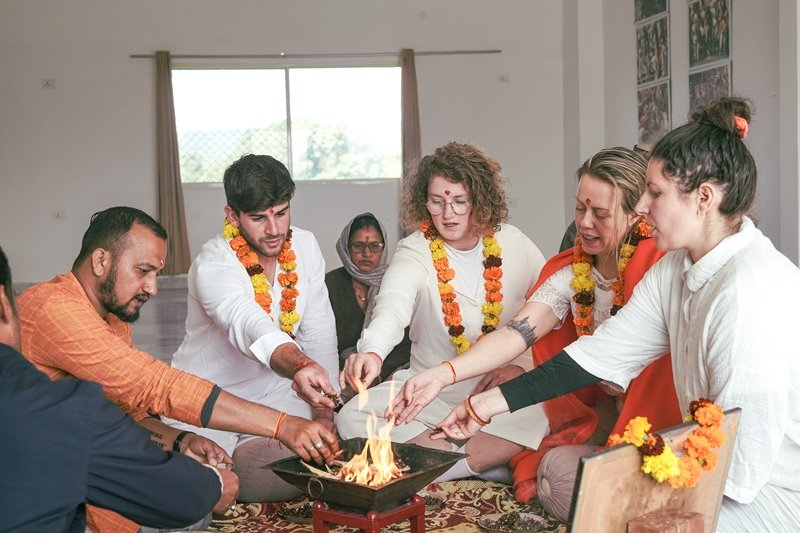
The Vedic fire ceremony, known as Yajna or Havan, stands as a beacon of timeless wisdom in an ever-evolving world. Deeply rooted in the Vedas, the ancient scriptures of India, this sacred practice symbolizes humanity’s intricate connection with the cosmos. Beyond being a religious ritual, the ceremony represents the universal principles of transformation, renewal, and harmony.
In a modern era often consumed by stress, disconnection, and environmental challenges, the Vedic fire ceremony offers a profound reminder of our interconnectedness with nature, our spiritual essence, and each other. It is more than an ancient ritual—it is a transformative experience that merges science, spirituality, and tradition, bridging the gap between the material and the divine. Let us embark on a journey to understand the origins, symbolism, process, and scientific relevance of this extraordinary practice and explore why it continues to inspire millions worldwide.
Origins of the Vedic Fire Ceremony
The origins of the Vedic fire ceremony can be traced back over 3,500 years, to the early Vedic period of ancient India. During this time, the relationship between humanity and nature was seen as sacred and symbiotic. Fire, or Agni, was revered not merely as a physical element but as a divine force, a living entity that acted as a bridge between the earthly and spiritual realms.
The Rigveda, the oldest Vedic text, contains numerous hymns dedicated to Agni. These hymns celebrate fire as a messenger carrying human prayers and offerings to the divine and returning blessings to the material world. This concept is not just symbolic but profoundly experiential: Agni was perceived as a transformative energy, capable of converting physical offerings into spiritual essence.
The Vedic fire ceremony evolved as a means of honoring Agni while aligning human intentions with cosmic energies. It became the centerpiece of both personal and communal life, addressing spiritual, social, and ecological needs. Over millennia, the Yajna adapted to different contexts, but its essence remains unchanged—a sacred act of connection, transformation, and renewal.
Fire: The Element of Transformation
In Vedic philosophy, fire represents far more than heat or light; it embodies the principle of transformation that governs the universe. Its role in the Yajna is rich with symbolic meaning:
Purification:
Fire is nature’s ultimate purifier. In the Vedic fire ceremony, offerings burned in the sacred flames symbolize the purification of negativity, attachments, and impurities. On a personal level, this act reflects the cleansing of the mind, body, and spirit. Scientifically, fire has been used for millennia to purify environments, a concept that resonates in the antiseptic properties of sacred herbs like sandalwood and camphor used during the ceremony.
Energy and Renewal
The act of burning transforms physical matter into heat, light, and ash—symbolizing renewal and rebirth. This mirrors the human journey: letting go of the old to make way for the new. Modern physics supports this idea through the law of energy conservation, which states that energy is never destroyed, only transformed—a principle that aligns seamlessly with the spiritual teachings of the Yajna.
Connection with the Cosmos
The rising smoke from the fire is believed to carry prayers and intentions to the celestial realms, connecting humanity with divine forces. While this may seem mystical, it also echoes the scientific idea of interconnectedness. Every action we take reverberates in the world around us, much like the particles of smoke disperse into the atmosphere, becoming part of the larger whole.
The Science Behind the Vedic Fire Ceremony
While spiritual at its core, the Vedic fire ceremony is also supported by scientific principles that amplify its relevance in the modern world.
Environmental Purification
Scientific studies have examined the purifying effects of smoke produced during fire rituals. Specific offerings, such as ghee, camphor, and medicinal herbs, release antimicrobial compounds when burned, purifying the air and neutralizing pollutants. This aligns with ancient claims that the Yajna creates a cleaner, healthier environment
Psychological Benefits
The rhythmic chanting of Vedic mantras during the ceremony has been shown to induce a meditative state, reducing stress and enhancing mental clarity. Research in neuroscience highlights how repetitive sounds can activate the parasympathetic nervous system, promoting relaxation and emotional well-being.
Social Cohesion
The communal aspect of the Yajna fosters a sense of unity, empathy, and shared purpose. Modern sociology supports this, showing that rituals strengthen social bonds and enhance collective resilience, especially during challenging times.
Aligning with Circadian Rhythms
Many Vedic fire ceremonies are performed at sunrise or sunset, aligning with natural circadian rhythms. This practice harmonizes the body with the earth’s cycles, promoting overall well-being—a concept validated by contemporary chronobiology.
The Process of the Vedic Fire Ceremony
The Vedic fire ceremony unfolds in a series of intentional steps, each rich with symbolism and significance:
Purification:
The ritual begins with the purification of the space, participants, and offerings. Holy water is sprinkled, and mantras are recited to cleanse negative energies and establish a sacred atmosphere. This preparatory phase not only sanctifies the environment but also helps participants focus their minds.
Invocation of the Divine:
Deities are invited to bless the ceremony, with Agni as the primary mediator. Prayers are offered with humility and gratitude, setting the tone for a meaningful spiritual experience.
Lighting the Sacred Fire:
The fire is kindled using sacred wood and clarified butter (ghee), symbolizing the awakening of divine energy. This act marks the transition from the mundane to the sacred, inviting participants to step into a space of transformation.
Offerings to the Fire:
Offerings such as grains, herbs, and incense are placed into the fire while chanting mantras. Each offering represents a specific intention—gratitude, purification, healing, or abundance.
Meditation and Reflection:
Participants meditate on their intentions and the transformative energy of the fire. This phase deepens their connection to the ritual, fostering inner peace and self-awareness.
Closing Prayers:
The ceremony concludes with prayers of gratitude and blessings for all beings. The fire is allowed to extinguish naturally, symbolizing the cycle of completion and renewal.
Types of Vedic Fire Ceremonies
The Vedic fire ceremony is as diverse as it is profound, with different forms tailored to various purposes and intentions:
- Graha Shanti Yajna: Performed to harmonize planetary influences and alleviate astrological imbalances.
- Vivaha Yajna: A central part of Hindu weddings, symbolizing the union of two souls.
- Agnihotra: A daily ritual at sunrise and sunset, purifying the environment and aligning participants with cosmic rhythms.
- Chandi Havan: Dedicated to Goddess Durga, this ceremony invokes strength, protection, and divine guidance.
- Pitru Yajna: Conducted to honor and appease ancestors, fostering familial harmony and spiritual liberation.
Emotional and Spiritual Benefits
The Vedic fire ceremony is a deeply emotional experience that nurtures the heart, mind, and soul:
- Inner Peace: The meditative chanting and sacred atmosphere create a sense of calm and clarity.
- Spiritual Awakening: Participants often report feeling a heightened connection to their higher selves and the universe.
- Gratitude and Humility: The act of offering promotes a sense of gratitude and surrender, helping individuals let go of ego-driven desires.
The Modern Relevance of the Vedic Fire Ceremony
In today’s fast-paced world, the Vedic fire ceremony holds timeless relevance. Its emphasis on mindfulness, environmental harmony, and spiritual growth resonates with modern values, offering:
- A sanctuary of stillness in an overstimulated world.
- A practice to combat environmental degradation through eco-conscious rituals.
- A tool for building community and fostering shared purpose.
Conclusion: Rekindling the Sacred Flame
The Vedic fire ceremony is more than an ancient tradition—it is a timeless journey into the heart of existence. By honoring the sacred flames, we are reminded of our interconnectedness with nature, our shared humanity, and the divine within.
Whether performed in a temple, a yoga retreat, or the quietude of a home altar, the Yajna continues to inspire and transform lives across the globe. It invites us to embrace the power of renewal, the beauty of surrender, and the eternal promise of growth.
Through its sacred flames, the Vedic fire ceremony offers a luminous path to balance, harmony, and awakening—a beacon of hope in an ever-changing world.












Leave a comment: